- Articles and Guides

Catalina 30 Review: Features, Performance and Tech Specs
7th feb 2024 by john burnham / samantha wilson.

The Catalina 30 has had a long and illustrious life and remains to this day a favorite on the used market. Over 6,400 Catalina 30s were sold during its 25-year production run starting in 1974, testament to its solid construction, functional layout, ease of sailing, a modest price, and the strong Catalina dealer network.
So what makes it so popular? While it’s not really intended as a bluewater cruiser, the Catalina 30 handles coastal and inshore sailing with ease. It is ideal for weekends or week-long cruises thanks to its cleverly thought-out interior space. Overall, the Catalina 30 sails well, is a stable design in stiffer winds, and can be sailed single-handedly by a competent skipper.
Despite several versions throughout its production run, including the MKII, first built in 1986, and the MKIII, in 1994, the basic dimensions of the model remained unchanged: LOA 29’11", beam 10’10", displacement 10,200 lbs., and standard draft 5’3". Likewise, the interior was never altered. Catalina’s approach to the huge success of the 30 seemed to be ‘if it ain’t broke, don’t fix it!’.
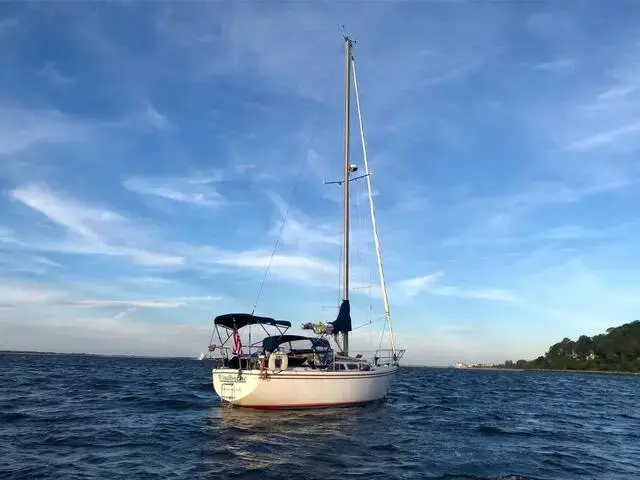
Catalina 30. Rightboat seller photo.
Catalina 30 Key Features
There have been many versions of the Catalina 30 throughout its long production run, with different configurations. There have been standard and tall rigs, each with a bowsprit option, as well as shoal, wing, and deep fin keels. Following on from the MKII in 1986, the MKIII in 1994 made some noticeable changes, namely a slight widening of the hull aft, which allowed for a transom boarding platform.
The Catalina 30’s hull, like all of Catalina’s models, is built of fiberglass and polyester resin, with a deck constructed of either balsa or plywood between fiberglass laminates. Belowdecks, the Catalina 30s layout remained unchanged throughout its life. With a wide companionway creating a spacious feel to the cabin, able to accommodate up to four with a separate head, large galley, and cozy saloon, it proved popular and user-friendly. The boat has an aft cockpit with a closed transom.
While this model undoubtedly ticked a lot of boxes for many sailors, it had a few common problems, as described in various owners forums. Compression fatigue at the maststep on deck and in the bilge under the compression post has been commonly reported over the years and may need to be fixed. Likewise, old wooden spreaders sometimes fail, and leaks and separation may be experienced at the keel-to-hull joint. Ensuring these are all inspected in a thorough marine survey when buying will highlight any issues the boat might have.
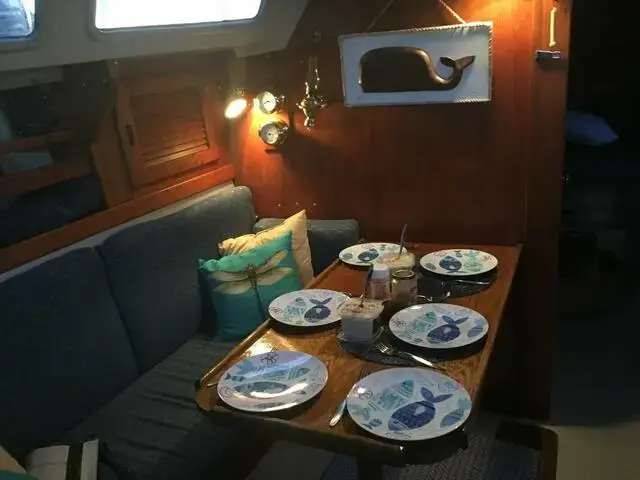
Catalina 30s spacious interior with separate cabin and dinette. Rightboat seller photo.
Catalina 30 Performance
The Catalina 30 impressively straddles the line between performance and comfort, offering decent speeds compared to competitors of the same era, despite a lower sail/displacement ratio of 15.22. The fin keel version has deeper draft, lowering the center of gravity and providing better performance upwind. A higher ballast/displacement ratio means the Catalina 30 stands up well in stronger winds.
Catalina 30 Why Buy It
- One of the top-selling 30-foot sailboats ever
- Spacious accommodation for up to 4 people including saloon and galley
- Wide, deep hull creates exceptional space above and below decks
- Known for its stability under sail
- Variety of models and variations to be found on the used market
- Good value for money on the used market with lots in circulation
- Buying used?: Possibly compromised deck cores and mast steps merit checking before purchase. For other tips when buying a used boat, read our Boat Inspection Checklist
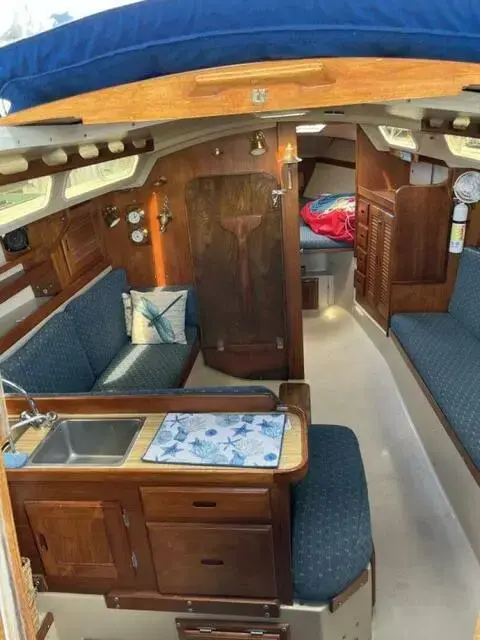
Galley and saloon of Catalina 30. Rightboat seller photo.
Catalina 30 Technical Specifications
- LOA: 29.92 ft
- Beam: 10.83 ft
- Draft: 5.25 ft
- Rigging Type: Masthead sloop
- Hull type: Fin w/spade rudder
- Displacement: 10200.78 lbs
- Ballast: 4200 lbs
- Ballast type: Lead
- Fuel tank capacity: 21 gallons
- Sail area/displacement ratio: 15.22
- Ballast/displacement ratio: 41.18
- Critical hull speed: 6.70 knots
- Engines (after mid-1980s): 3-cylinder Universal M-25 diesel engine

Enclosed cockpit and seating of Catalina 30. Rightboat seller photo.
Check out all the Catalina boats for sale
Written By: John Burnham / Samantha Wilson
John Burnham is a marine editor and writer with decades of journalism experience as Chief Editor of boats.com, Sailing World, Cruising World, and other boating websites. As a competitive sailor, he has led teams to world and national titles in the International One-Design, Shields, and other classes. Based in Newport, Rhode Island, John is a PCC leadership coach, a member of the America’s Cup Hall of Fame Selection Committee, and a past board member of Sail America and US Sailing. For more, see johnsburnham.com .
Samantha Wilson has spent her entire life on and around boats, from tiny sailing dinghies all the way up to superyachts. She writes for many boating and yachting publications, top charter agencies, and some of the largest travel businesses in the industry, combining her knowledge and passion of boating, travel and writing to create topical, useful and engaging content.
More from: John Burnham / Samantha Wilson
Related Articles and Guides
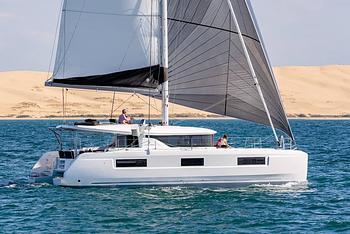
31st Mar 2024
Lagoon 46 Review, Spacious Bluewater Catamaran
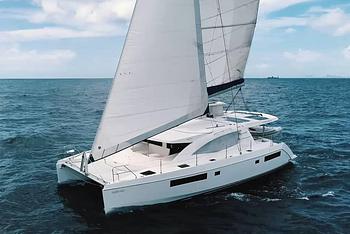
21st Mar 2024
Leopard 48 Review: Features, Performance and Tech Specs
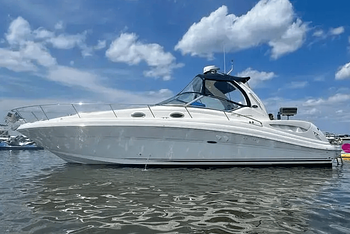
13th Mar 2024
Sea Ray 340 Sundancer Review, an Iconic Cabin Cruiser
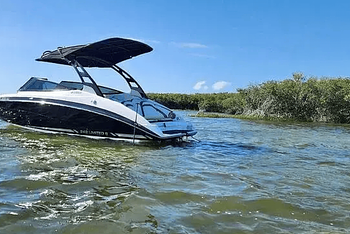
29th Feb 2024
Yamaha 242 Limited S Review: Features, Performance and Tech Specs
- Explore Rightboat
- Boats for Sale
- Boating Articles
- Buyers Guide
- About RightBoat
- Sell Your Boat
- Boat Selling Advice
Enter your email to keep up to date with the latest news
Join for free
Sign up now for free and discover how easy it is to keep up to date with THE latest boats for sale. Find your right boat, and tailor your voyage to finding your next boat.
Benefits of becoming a member:
- Set up tailored alerts
- Personalise your experience
- Download full specifications and broker details
- Keep tabs on your favourite boats
Are you a broker? Join as a Broker
Rightboat - join for free.
Do you have an account already? Login
Save this search
Save your search and receive new boats in your email..
You can unsubscribe from your alerts whenever you like. By pressing the button you accept the Legal Terms and conditions

- Boats & Gear
- Instructional
- Cruising Stories
- Cruising Destinations
- Race Results
- Race Reports
- Racing Technique
- Submit a Classified Ad
- Boats for Sale
- All Classifieds
- Terms & Conditions
- Your Dashboard
- Seattle Area Racing Calendar (SARC)
- 48° North Cruising Rally
- Croatia Flotilla
- Catalina 425 Boat Review
- Boat Reviews
A Sail Test On An Award-Winning American-Built Cruising Boat
From the April, 2020 issue of 48° North
My first crossing of the Strait of Juan de Fuca was aboard a wing-keel Catalina 42 that bounded comfortably in six-foot-seas and 25 knots—it remains a favorite, formative sail. Roughly 1,000 of these venerable cruisers were built over more than two decades (between Mk I and Mk II iterations). And, as is common with Catalinas, they boast some of the industry’s most loyal owners.
However, in spite of my enduring appreciation for the Catalina 42, my personal opinion is that the design has been ready for a modernizing overhaul for some time. Enter the new Catalina 425. Based on my recent test sail experience on the 425 in February and the incredibly positive response it has received from sailors and critics alike, it seems that the Catalina crew have hit a home run in this new generation redesign.
Decidedly Modern with Traditional Elements
While sleek, attractive, and modern, the Catalina 425 is a bit more traditional than it is flashy in its styling. It doesn’t have some of the things I associate with many modern production cruisers—there aren’t hard chines or a plumb bow, for example. Lead designer, Gerry Douglas, shares his decision calculus for much of this right in the marketing materials, indicating his sentiment that chines often cause hydrodynamic turbulence and reasoning that his chosen 9-degree bow angle maximizes waterline length while providing good protection from anchors. To me, it helps to know why the boat doesn’t look just like some of the others, and the reasoning is sound.
The 425 is on the lighter-displacement side of its group of competitors, displacing 17,500 lbs. However, its 7,000 pounds of ballast is more than most similar designs, except for those with significantly heavier displacement. With a sail-area-to-displacement ratio of 21.69, in combination with its lighter displacement and heavier-than-most ballast, the Catalina 425 has construction and performance attributes that make it an ideal blend of American-built tradition and sailing capability, and is a notable step forward in performance from its predecessor.
Easy and Impressive Under Sail
We had a great opportunity to see the range of performance across light-to-moderate conditions during our test sail. We set the in-mast furling main and self-tacking jib in barely 5 knots of breeze. The boat moved but, as most any cruising boat would in breeze that light, it would have preferred more pressure. There are tracks on the deck alongside the cabin top where a larger, traditionally-sheeted genoa would surely have felt like the right sail choice early in our test. The inboard chainplates will allow for proper, upwind-friendly sheeting angles on the genoa.

Nonetheless, I was pleasantly surprised by the boat’s get-up-and-go with the stock jib as the breeze trended above 5 knots. By the time we had 6 to 8 knots, it didn’t feel irresponsible to be playing with apparent wind angles around 35 degrees while still feeling good power in the sailplan and great feel in the helm. Especially since our test boat was the fin-keel version with a draft of 6-feet 8-inches (instead of the wing-keel arrangement that’s popular in shallower cruising areas), I felt that the performance to weather was particularly impressive for a cruising boat as comfortable as this. As the breeze built above 10 knots, I liked the sailing experience more and more.
Familiar Feel On The Helm
Honestly, it was satisfying to drive a cruising boat that had a familiar feel under sail. Elements that are nearing ubiquity for many modern production boats require some mindset adjustment. Almost none of us learned to sail on dual-rudder boats with significant chines. To drive the Catalina 425 felt comfortable, responsive, and intuitive. It was like I knew what the boat needed. Surely, performance could suffer if sailing over-canvased and significantly heeled in big breeze, but smart sail choice and trim should easily remedy those challenges and make for a happier crew.
The twin helms are appropriately sized and adequately spaced. As I switched from helm station to helm station through easy tacks that required only a turn of the wheel thanks to the self-tacking jib. I appreciated the ability to trim both the main and jib sheets form the port-side helm station. The appeal and ease of the self-tacking jib and in-mast-furling main are obvious. These systems typically represent some compromise in performance, but I was pleased with the pliability of trim for the jib and especially the main, for which the rare-these-days inclusion of a mainsheet traveler on a cruising boat made trimming the furling main far more enjoyable. The German mainsheet system has its turning-block terminus closer to the end of the boom than you see on many European-built competitors. This both reduces the risk of a boom-failure and keeps mainsheet loads more manageable because of a better leverage point.
Off the breeze, the beamier aft section contributes to stability. The downwind sailing felt easy and always under control, but the stock jib isn’t the ideal sail for downwind cruising. Luckily, the rig is fractional, with room for an asymmetrical spinnaker utilizing either a furler or sock above the forestay attachment.
Space to Spare
A spacious and ergonomic cockpit has long been one of Catalina’s strengths, and the 425 is no exception. The saltiest ocean-going cruisers sometimes point to large cockpits as a safety risk, but for 99-percent of sailors 99-percent of the time, a large cockpit is an asset. In this way, the 425 excels. Twin helms make movement around the cockpit easy, the fixed central table provides a great handhold or foot-push and has a built-in fridge compartment, the signature Catalina stern pulpit seats give guests a great view and more seating room, and a starboard bench seat that converts into a double-berth-lounger is a smart and luxurious innovation.

Modern efficiencies can be found in things like recessed hatches and under-deck leads for two lines per side that run to the helm stations. Safety is improved by the extension of the stainless steel stern pulpit further forward than most boats—instead of life lines around the cockpit, you have sturdier, more stable “life bars” as an enclosure. From the helm station, visibility was very good thanks to flat side decks and a low-slung cabin top. All-in-all, life on deck is pretty grand.
Clever and Comfortable Interior Design
It will come as no surprise that the interior of the 425 is very comfortable. Numerous clever details appealed to me. While many European designs offer a host of customizable layout options, Catalina has simplified and innovated. A three-cabin model is standard, but the port double-berth can tilt up clearing space along the centerline—making it part cabin, part garage. Moving the berth out of the way offers convenient, excellent access to the 57-horsepower Yanmar and the steering and running gear systems behind.
The forward cabin is clearly intended to be the owner’s quarters, with en suite head and a spacious central berth that can accommodate sailors who are 6-feet 5-inches or taller. This V-berth bed also has a unique lifting system for a more upright reading position and better views out of the hull portlights. Forward of this cabin is a watertight crash bulkhead.
Headroom is NOT an Issue
Standing headroom of a whopping 6-foot 9-inches in the main salon creates an almost vaulted ceiling sensation of space. Along with the wide beam, ample light from numerous portlights and a large overhead hatch, and really nicely done finish work with grain-matched teak, the salon is relaxing, elegant, and spacious. The dinette to port is matched by a settee with a navigation station that can be converted to seating. Unlike some convertible nav stations, the 425’s adaptation still has a drawer for tools and chart stowage.
Solid handholds can be found throughout including, importantly, above the galley, which is C-shaped. There, you will find a large front-opening fridge, an additional top-loading fridge-or-freezer on a separate breaker, and another dry-storage compartment that could be used as an icebox if you chose to deploy it that way. That’s pretty great flexibility without customization.
From liveability to sailability, the Catalina 425 delivers. It would be an ideal boat for large or growing families; and with its solid performance characteristics and ease of use, it’s a sailboat you might sail more during the Pacific Northwest cruising season.
Thanks to Windworks Sailing and Powerboating for taking me sailing. Photos courtesy of Catalina Yachts.

Joe Cline has been the Managing Editor of 48° North since 2014. From his career to his volunteer leadership in the marine industry, from racing sailboats large and small to his discovery of Pacific Northwest cruising —Joe is as sail-smitten as they come. Joe and his wife, Kaylin, welcomed a baby girl to their family in December 2021, and he is enjoying fatherhood while still finding time to sail, make music, and tip back a tasty IPA every now and again.
Adventure Stories , Featured
Sea Adventurer: An Interview with Kirsten Neuschäfer, Part 1
April 4, 2024
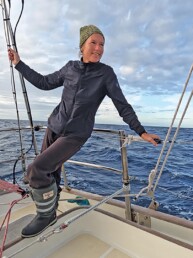
Boating News , Featured
Friday Harbor’s Opening Day Boat Parade Set for Sunday, May 5
April 3, 2024
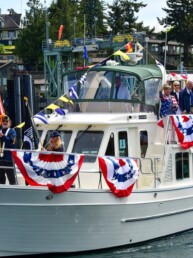
Racing , Featured
Eastsound Spring Regatta Moved to West Sound for 2024
April 2, 2024
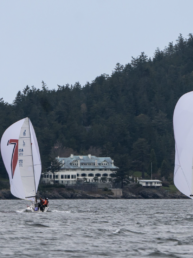
Instructional , Featured
Get into Youth Sailing in the PNW: A Parent’s Guide
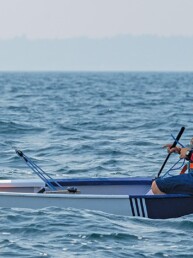
Race Reports , Featured
Optimism Delivers: CYC Pulley Point Race
March 29, 2024
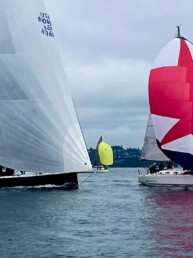
Boating Lifestyle , Featured
Editor’s Letter: The Spirit of Adventure
March 28, 2024
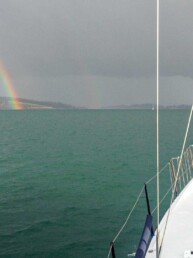

Common Issues With Catalina Yacht Sailboats

Last Updated by
Daniel Wade
August 30, 2022
Catalina sailboats have always been known for durability and quality, but they have some common issues to look out for.
Catalina sailboats, especially older vessels, commonly suffer from deck core failure, mast boot compression fatigue, keel separation, chain plate attachment failure, and fiberglass delamination issues.
In this article, we'll cover six of the most common problems unique to Catalina sailboats. Additionally, we'll show you how to spot these issues, along with a general idea of the time and effort required to repair them.
We sourced the information in this article from Catalina sailboat owners and sources familiar with repairing these vessels.
Table of contents
Do Brand New Catalina Sailboats Have Any Problems?
Generally no, brand new Catalina Yachts are extremely high-quality and have virtually no common issues down the line. These sailboats are manufactured using the highest-quality materials that are economical.
And thanks to modern manufacturing techniques, even the best materials are now affordable for standard sailboats. Catalina yachts are high-end sailboats today and cost upwards of $200,000 in many cases. Thus, you can expect top-quality reliability and design.
Do Older Catalina Sailboats Have Any Problems?
Used Catalina sailboats are a different story. These boats were produced and sold at a much lower price point and with more 'standard' quality materials. For example, veneer was used instead of wood in some applications and whatnot.
However, they're still great boats—some of the best on the used market. Catalina yachts are affordable, especially the models built en masse in the 1970s and 1980s.
Most Common Problems with Catalina Sailboats
Catalina sailboats are some of the most numerous ever produced. These boats were built during a time when fiberglass boat building was fairly well established, but we didn't have as many quality materials to choose from.
It has been over 50 years since the first Catalina yachts rolled off the production line, and we've learned a lot since then. Additionally, despite their high quality, there are some common issues with these boats that warrant some inspection by owners and prospective buyers.
Here are some of the issues we look out for, along with how to spot them on used Catalina yachts.
1. Broken Mast Stays
Standing rigging is extremely important on Bermuda-rigged sloops, especially fiberglass vessels with aluminum masts. Unlike solid-masted vessels, like gaff-rigged catboats, virtually all Catalina sailboats rely on stainless steel stay cables to keep their masts up.
It's common on older Catalina sailboats for stays to be corroded or improperly tightened. This is bad news, as it often leads to complete stay failure and subsequent mast collapse. You should always inspect your standing rigging on an old fiberglass sailboat and replace it promptly if it stretches or shows signs of corrosion.
2. Deck Failure from Water Ingress
Old Catalina sailboats are notorious for deck failures, and they're pretty easy to spot once the degradation becomes advanced. Deck failure on Catalina sailboats is usually caused when water or rot makes its way into the organic deck core material and rots it away.
Remember, the decks of fiberglass boats are usually made from a combination of wood, foam, particleboard, and fiberglass for strength and water tightness.
When the outer layer deteriorates or cracks, water can get inside and turn the structural support below into worthless goo. Then it's only a matter of time before someone's boot makes a hole in the deck, which was once safe to walk on.
Usually, small soft spots in the deck of a Catalina sailboat can be repaired with relative ease, though it will require you to cut out and remove the affected area. It becomes a bigger issue when the rot affects a more vital area of the boat, such as a structural support beam.
You can find weak spots in the deck by looking for play in the deck surface. Usually, a weak spot will feel spongy or buckle under your weight. If you're walking around on the deck (on a surface that's supposed to be stepped on) and the deck moves from your weight, it's a bad sign.
3. Mast Compression Fatigue
Catalina masts are usually fastened to a strengthened point on the deck. If you follow the mast below decks, you'll notice a wooden beam (usually part of the woodwork between compartments) which leads to a solid mast step below the deck.
Catalina masts are held down by the stays with tremendous pressure, as hollow aluminum masts can be pushed hard but not bent. This transfers a heavy load through the support beam in the cabin and into the block in the floor. Over time, this pressure can deform or crack the compression post block.
This phenomenon is called compression fatigue, and it's pretty easy to spot. You probably won't have any indication of compression fatigue from the above decks unless the deck below the mast begins to sag noticeably. By that point, you've got bigger problems to deal with, and the vessel will need extensive repairs.
You can spot compression fatigue in a few ways. First, severe fatigue will usually be visible from the deck itself in the form of a sunken mast mount or cracks around the surface. Inside, any deformation or cracking in the ceiling around the compression post is cause for concern.
Finally, you can look below the floor at the mast block and look for cracks or deformation. A healthy mast block will have nice, even lines and an asymmetrical appearance. Most importantly, the top will be flat, and the fiberglass around the top of the post will be straight and free of cracks.
4. Keel and Hull Separation—The "Catalina Smile"
One of the most notorious failures on older Catalina sailboats is the separation of the keel and hull. Catalina sailboats are designed with a joint that connects the hull and the keel section of the vessel, and this area is known to fail from running aground or just from aging.
In fact, this form of separation is so common that there's a name for it. Sailors call it "the Catalina Smile," and it refers to the smile-shaped separation that occurs on the leading edge of the keel. This is an issue that anyone buying a 30+-year-old Catalina should definitely look for.
So what happens? This is due to the way the keel mounts to the boat. Catalina sailboats usually use heavy lead keels that are bolted to the bottom of the hull. These keels separate due to stretched fiberglass, impact, and loosened bolts.
It also happens when, over time, the seal between the keel and the hull fails and water corrodes the bolts. This problem isn't unique to Catalina sailboats—it can happen on any fin keelboat. It's common because the company was an early and widespread adopter of the fin keel design.
So can it be fixed, and is the Catalina Smile a fatal flaw? It depends entirely on the extent of the damage and when it occurs. If corroded bolts cause the keel to loosen, it can swing from side to side and crack the hull. There are a few cases of boats sinking this way.
But if it's not too severe, then you can have a competent boatyard repair it for a reasonable price. Additionally, you don't have to repair all cases of the Catalina Smile immediately, as minor cases require attention but aren't an immediate threat to the boat.
5. Chain Plate and Chain Plate Attachment Failure
Chainplates and chain plate attachments occasionally fail on Catalina sailboats, especially if they've been allowed to corrode. Another common cause of chain plate failure is the use of dissimilar or weak metals for replacement parts.
Some of these sailboats are over 50 years old. There have likely been many owners, and some may have improperly replaced chain plate attachments over the years.
Some use hardware store parts to replace high-strength and corrosion-resistant rigging components, which can break under pressure or cause irreversible galvanic corrosion when exposed to saltwater.
Luckily, this isn't the end of the world on used Catalina sailboats. Assuming the chainplate hasn't deformed the hull or torn out, you can replace all the potentially dangerous parts and bolts for a reasonable cost.
Failure most often occurs around chainplates when sails are deployed or when rigging is tightened. Replace all corroded or questionable parts before tightening rigging, and especially after you upgrade your standing rigging.
6. Fiberglass Delamination
Fiberglass delamination is a common issue on earlier fiberglass boats, especially those produced by Catalina in the 1960s and 1970s. Fiberglass delamination happens due to exposure to sunlight, abrasion, and water ingress, and it can happen almost anywhere on the boat.
Delamination occurs when one (or several) layers of fiberglass cloth become unglued from the others. Since Catalina sailboats are built with several layers of cloth, the occasional delamination due to age or abuse isn't uncommon—and it usually isn't immediately catastrophic.
Delamination can become an issue if it runs deeper than the first layer. Additionally, de-lamination can allow water to seep into the core and rot out the deck from within—a process that is extraordinarily difficult to stop once it starts.
Luckily, most cases of fiberglass delamination can be repaired with relative ease. Small areas of delamination can be fixed with a simple fiberglass cloth and resin kit from West Marine or by an experienced boatyard for a reasonable cost.
Related Articles
I've personally had thousands of questions about sailing and sailboats over the years. As I learn and experience sailing, and the community, I share the answers that work and make sense to me, here on Life of Sailing.
by this author
Learn About Sailboats
Most Recent

What Does "Sailing By The Lee" Mean?
October 3, 2023

The Best Sailing Schools And Programs: Reviews & Ratings
September 26, 2023
Important Legal Info
Lifeofsailing.com is a participant in the Amazon Services LLC Associates Program, an affiliate advertising program designed to provide a means for sites to earn advertising fees by advertising and linking to Amazon. This site also participates in other affiliate programs and is compensated for referring traffic and business to these companies.
Similar Posts

Affordable Sailboats You Can Build at Home
September 13, 2023

Best Small Sailboat Ornaments
September 12, 2023

Discover the Magic of Hydrofoil Sailboats
December 11, 2023
Popular Posts

Best Liveaboard Catamaran Sailboats
December 28, 2023

Can a Novice Sail Around the World?
Elizabeth O'Malley
June 15, 2022

4 Best Electric Outboard Motors

How Long Did It Take The Vikings To Sail To England?

10 Best Sailboat Brands (And Why)
December 20, 2023

7 Best Places To Liveaboard A Sailboat
Get the best sailing content.
Top Rated Posts
Lifeofsailing.com is a participant in the Amazon Services LLC Associates Program, an affiliate advertising program designed to provide a means for sites to earn advertising fees by advertising and linking to Amazon. This site also participates in other affiliate programs and is compensated for referring traffic and business to these companies. (866) 342-SAIL
© 2024 Life of Sailing Email: [email protected] Address: 11816 Inwood Rd #3024 Dallas, TX 75244 Disclaimer Privacy Policy

The Bahamas
US East Coast

Catalina 400 mkII, Shopping for a Floating Home

The Catalina 400 mkII was a beautiful boat to walk through, and we really enjoyed looking at it. Last week, we released our 14th episode, which was a video boat tour of the Catalina 400 mkII. In previous previous reviews, we saw a Catalina 350 and a Catalina 42 . Now, the 400 – right in the middle.
Here’s a quick review of the highlights and drawbacks for our needs as liveaboards.
Rated For All Oceans
First things first – the Catalina 400 mkII is rated A for all oceans. This means we won’t regret buying and then being restricted to our little bay. The boat, like the Catalina 350 and the Catalina 42 , is built strong and is ready for the rigors of the sea – in good weather of course. 🙂
While you can find several Catalina 400s for sale in Europe (indicating a successful Atlantic crossing), it’s really more of a racer/cruiser.
We don’t care to race a sailboat, but we do intend to cruise.
Is the Catalina 400 Good For Cruisers?
Let’s start in the cockpit. It’s a great touch to have twin helms in the cockpit as it really opens up some walking space.
Safe and Comfortable
For a family of three wanting to take up residence on a boat, every 12 inches of walking space is appreciated!

And the cockpit does feel spacious, but not too open that you’ll stumble and fall during a choppy sail. The combings (backrests) are high and safe, and the seats are deep enough to enjoy a night sleeping under the stars (I can’t wait to do that!).

You can see in the picture above, that the construction is thick and rigid with plenty of surfaces to lean onto or solid stainless steel to hold to when the winds are blowing and waves are tumbling.
With a beautiful daughter and little puppy, safety is number 1 in what we’re looking for in our cockpit!
Spacious, Yet Safe Deck
One thing we love about Catalinas is how clean and open the deck space is. The side decks are wide and clear, which makes them comfortable to move around and safe to walk on while sailing.

And the cabin top and bow area are also open and clear with plenty of room to layout, hang a hammock, or relax watching the sunset!

Challenges with Living on a 400 mkII
We’ve asked a few sailors about the Catalina 400, and overall there seems to one major challenge with living on the 400: storage space.
Yes, it’s a long “400” at 41 feet, but it also has a large aft cabin for comfortable sleeping arrangements. With that large cabin, you loose locker space for gear and equipment.

So there’s the major compromise on this sailboat.
You can have lovely leather seating on each side of the queen berth (bed), but you lose out on storage for exterior type gear and machinery.
Every boat has its compromise, and this is the Catalina 400’s weak point.
Catalina 400 mkii Sailing and Safety
This sailboat is a good length for offshore sailing, though is does carry quite a bit of beam forward, which will indicate a rougher ride when the waves pick up. Also the beamy stern will make for some rolly sailing downwind. But overall, the Catalina 400 should be solid and is rated for open oceans.
Renowned yacht designer Ted Brewer reviewed the Catalina 400 when it first debuted in 1995. He sums it up this way:
Nevertheless, despite some nitpicks, mostly minor, this is a fine boat. The Catalina 400 is handsome, she sails well, she has a very comfortable interior; and the price is certainly reasonable for all that she offers as a versatile coastal cruiser and occasional club racer.
What are your thoughts? Doesn’t she look beautiful?
If you read this far, you’re a real friend, and I’d love to continue talking with you in the comments below!
Cheers, Matt.
2 responses to “Catalina 400 mkII, Shopping for a Floating Home”
[…] life has been hectic in the last 2 months. Layered underneath all the sailboat shopping (see here, and there, and everywhere!) has been the need to sell all of our […]
[…] example, the Catalina 400 and the Catalina 42 are both shorter boats overall, but they are wider and made better use of the […]
Leave a Reply Cancel reply
Never miss a blog post.
Drop your email below.
Type your email…

Copyright 2023 The Foster Journey. All Rights Reserved. Proudly powered by Mafost Marketing
Session expired
Please log in again. The login page will open in a new tab. After logging in you can close it and return to this page.

- Forum Listing
- Marketplace
- Advanced Search
- About The Boat
- Boat Review Forum
- SailNet is a forum community dedicated to Sailing enthusiasts. Come join the discussion about sailing, modifications, classifieds, troubleshooting, repairs, reviews, maintenance, and more!
Best year for 30' Catalina? and why...
- Add to quote
I'll toss out another one: If you could have any Catalina 30, which model year(s) would you want to own and why? Which year(s) would you avoid, and why?
Wingman, Pre-1988 C30s have a wood laminate keel stub, which is said to cause the "Catalina smile," and which in turn causes crevice corrosion of the keel bolts. A sailor who goes by Halakai on this forum has the whole nine yards on the problem, while another truly wise sailor (Max Munger) says the problem is somewhat exaggerated. I've decided not to give a ***k. I own a 1980 C30, and she's been a great ship. Good luck.
I have an 83 and the only problem I have had has been leaking windows. I think all 30s over 15 years old have leaky windows and need to be re-bedded. Other than that, no real problems.
Was it just the 30's that had the wood keel stub? What was in the 34's and 36's?
Catalina improves their boats throughout the production run. I've never heard of them making a major mistake doing that. The later in the production run, generally, the better. I'm very happy with my 1984 C30. I like the MKII models better because I like the T shaped cockpit. I'm getting old and tired of climbing around the wheel. That being said, I don't care much for the look of the extra ports in the MKIII, but that's just me. In general, I'd prefer a newer one. David
The hull has not changed over the years. The transom is different, certainly different materials in parts, but the hull remains almost a constant. Find one you like and can afford, have it surveyed, and if you love it, buy it. They made over 10,000 of them before they moved on to the 309, so there are a lot to choose from. Good ones usually don't last long.
So you would say any 1980 style is good
They made a lot of them, and they are generally really good boats for the price. The tall rig is much better than the standard rig, and is also much more highly sought after.
- ?
- 174K members
Top Contributors this Month
- BOAT OF THE YEAR
- Newsletters
- Sailboat Reviews
- Boating Safety
- Sailing Totem
- Charter Resources
- Destinations
- Galley Recipes
- Living Aboard
- Sails and Rigging
- Maintenance
- Best Marine Electronics & Technology
Catalina 380
- By Herb McCormick
- Updated: December 5, 2001
When one of the biggest production sailboat builders in the world corrals top honors in a no-holds-barred fleet of extremely able contenders — including some candidates that fetch tens of thousands of dollars more than the winning yacht — it’s time to take serious notice. So gather around for a look at the breakthrough 1997 Midsize Cruiser Of The Year — the Catalina 380.
The Catalina 380 was designed and built for weekend and vacation sailing with the added capability of an occasional offshore jaunt and extended sabbatical cruise. When the choices narrowed during final deliberations, the judges pondered a simple question: Of the 10 boats in the class ranging from 32 to 39 feet, which would they choose were they about to embark with their families on a no-nonsense voyage of 1,000 miles or so, culminating in a season aboard cruising Mexico or the Caribbean? The nod went to the larger of two impressive new Catalinas.
Size was of course a factor, but so too was value. With a base price of under $125,000 in true sailaway condition, the 380 is outfitted with a top-shelf list of gear and equipment. Among the standard components: Edson steering station, Schaefer roller furling, Adler Barbour refrigeration, Westerbeke 42-horsepower diesel engine, Maxwell windlass, Autohelm instruments for wind, speed and depth, Lewmar winches, Dutchman mainsail system, Z-spar mast, Garhauer blocks, and Spinlock rope clutches.
Catalina engineer Gerry Douglas and his design team canvased the opinions of previous Catalina owners, particularly those who’d owned and sailed models in the builder’s 32- to 36-foot range. In the layout down below, the consensus was to eliminate the double heads featured in a previous Catalina 38 in favor of a big single head, to install more storage (three cedar-lined hanging lockers plus a dedicated wet locker), and to include a good navigation station (with its own comfortable, spring-loaded seat).
All pumps are centrally located and well labeled for trouble-free servicing. Engine access is outstanding, as good as it gets on a boat this size; a “wet area” for fuel and water filters contains leaks and contributes to a dry bilge. Anchor chain is led below by way of a straightforward chute that provides an excellent fairlead. Ventilation, by way of six cabin-top hatches and eight opening ports, is plentiful. In the interest of simplified maintenance, there’s not a splinter of topside teak. With a very complete, fully indexed manual, it’s a boat meant to be looked after by its owner — not by a high-priced service yard.
Construction is simple, but stiff and strong. A separate molded grid section is bonded into the solid fiberglass hull while it’s still in the mold. The hull liner — sometimes relied upon for structural support in production building, but redundant on this boat due to its independent glass grid — is then installed over a layer of cavity-filling foam. It’s a new process for Catalina, and one they’re pleased with. The external lead keel is available in fin or wing options; it is secured with bolts to American Bureau of Shipping (ABS) standards. The hull/deck joint consists of an external flange bonded and bolted in place and capped with a sturdy vinyl rub rail.
For the accommodation plan, there is a choice between dual aft cabins or a single aft stateroom; the latter version was entered in the Boat Of The Year competition. There are fiddles and bins and shelves in both cabins for storage and loose stuff. The dining table drops down within the wraparound settee to form an “emergency” double. The head, to starboard, is accessed either from the aft stateroom or from the central saloon. On the opposite side of the companionway, the galley revolves around a two-burner propane stove unit. There’s plenty of counter space, a double sink and even an overhead “island” for cups and glasses.
Topside, the Catalina 380 is equipped with a deck-stepped, two-spreader rig available in standard or tall versions. The mainsheet and traveler are set up in a mid-boom arrangement forward of the companionway with the double-ended sheet eventually led aft to a pair of coach roof-mounted winches. Halyards and reefing lines also are brought aft to group the bulk of sail-handling chores in a safe, centralized location. The deck is arranged around a huge, uncluttered cockpit, the centerpiece of which is a fixed drop-leaf table for dining at anchor. A walk-through transom completes the back end of the boat.
Reading between the lines, the non-dimensional numbers for the 380 tell an interesting story. With a Displacement-to-Length ratio of 249, the Catalina registers a slightly more conservative figure than that generated by the venerable Valiant 40 (Disp/Length = 240), a design introduced almost 20 years ago and widely thought to signal the birth of the so-called “performance cruiser.” But with a Sail Area/Displacement number of 17.3 for the tall rig — compared to the Valiant’s 16.47 — there’s plenty of compensating power in the sail plan. Perhaps most surprising, with a displacement of 19,500 pounds, the 380 is about the heaviest boat in this year’s midsize class. Any way you look at it, this is a substantial vessel. Combine that with sprightly sailing qualities and generous interior volume and you’ve got a winner.
- More: 31 - 40 ft , before 2000 , catalina , Coastal Cruising , monohull , Sailboat Reviews , Sailboats
- More Sailboats
Sailboat Preview: Dufour 44
New to the fleet: pegasus yachts 50, balance 442 “lasai” set to debut, sailboat review: tartan 455, how to protect your spars from corrosion, sailing totem refit series: the forward head makeover, fatty goodlander: dealing with chafe while cruising, route planning in the face of climate change.
- Digital Edition
- Customer Service
- Privacy Policy
- Email Newsletters
- Cruising World
- Sailing World
- Salt Water Sportsman
- Sport Fishing
- Wakeboarding
- New Sailboats
- Sailboats 21-30ft
- Sailboats 31-35ft
- Sailboats 36-40ft
- Sailboats Over 40ft
- Sailboats Under 21feet
- used_sailboats
- Apps and Computer Programs
- Communications
- Fishfinders
- Handheld Electronics
- Plotters MFDS Rradar
- Wind, Speed & Depth Instruments
- Anchoring Mooring
- Running Rigging
- Sails Canvas
- Standing Rigging
- Diesel Engines
- Off Grid Energy
- Cleaning Waxing
- DIY Projects
- Repair, Tools & Materials
- Spare Parts
- Tools & Gadgets
- Cabin Comfort
- Ventilation
- Footwear Apparel
- Foul Weather Gear
- Mailport & PS Advisor
- Inside Practical Sailor Blog
- Activate My Web Access
- Reset Password
- Customer Service

- Free Newsletter

Tartan 30: An Affordable Classic

Ericson 34-2 Finds Sweet Spot

How to Sell Your Boat

Cal 2-46: A Venerable Lapworth Design Brought Up to Date

Solar Panels: Go Rigid If You have the Space…

Leaping Into Lithium

The Importance of Sea State in Weather Planning

Do-it-yourself Electrical System Survey and Inspection

When Should We Retire Dyneema Stays and Running Rigging?

Rethinking MOB Prevention

Top-notch Wind Indicators

The Everlasting Multihull Trampoline

What Your Boat and the Baltimore Super Container Ship May Have…

Check Your Shorepower System for Hidden Dangers

DIY survey of boat solar and wind turbine systems

What’s Involved in Setting Up a Lithium Battery System?

Waste Not is the Rule. But How Do We Get There?

The Scraper-only Approach to Bottom Paint Removal

How to Handle the Head

The Day Sailor’s First-Aid Kit

Choosing and Securing Seat Cushions

Cockpit Drains on Race Boats

Re-sealing the Seams on Waterproof Fabrics

Safer Sailing: Add Leg Loops to Your Harness

Waxing and Polishing Your Boat

Reducing Engine Room Noise

Tricks and Tips to Forming Do-it-yourself Rigging Terminals

Marine Toilet Maintenance Tips

Learning to Live with Plastic Boat Bits
- Sailboat Reviews
Catalina 42 Mk I and Mk II
One of the most successful large boats ever built, the catalina 42 offers good looks, comfortable accommodations, and decent sailing ability at a low price..
Under the guidance of Frank Butler, who founded the company in 1969, Catalina Yachts’ philosophy is to offer “as much boat for the money as possible.” The boats are relatively well made and reasonably contemporary in their designs.
Butler is able to build boats that are less expensive than similarly sized vessels by focusing on several areas: a) economy of scale; because it builds so many boats, Catalina can get a better price than smaller builders on diesel engines and just about any other equipment; b) a refusal to spend money on advertising, which can translate to a 5% to 10% savings in the cost of each boat, and c) installation of less expensive gear than is found on other boats. It’s likely, too, that the Southern California labor pool works for less than workers in, say, the Pacific Northwest or Northeast.
Catalina’s objective is to price its boats 15% to 20% below its major competitors—Hunter and Beneteau. All three are high-volume builders that move boats through the production line as quickly as possible, hence the opportunity for glitches here and there, most of which are seldom serious, but can be vexing.
The Catalina 42 In the words of Gerry Douglas, Catalina’s chief engineer and designer for the past 24 years, “The Catalina 42 is a rather simple, sturdy boat. What you get is good quality, because the structure is there. If you want to make it more elaborate, you can take it as far as you want to go.”
Introduced in 1989, the Catalina 42 was originally envisioned as a 40-footer.
“We followed in the footsteps of the designs for the 36- and 38-footers, which were very successful, then stretched this two feet to allow room for the swim platform,” he said.
“One objective was to build a three-stateroom boat,” the first of its size introduced by an American production builder, Douglas said.
Two versions of the Catalina 42 have been built, each in a two-or three-stateroom configuration. The Mark I (hulls #1-477) was produced until February 1995, when the Mark II, which is still in production, was introduced. More than 670 have been built, evenly divided between the two- and three-stateroom models.
“The design of the Mark II was influenced somewhat by the Europeans,” Douglas said, referring to the contemporary, rounded stern and modifications to the cockpit.
Just about everything else—the hull, deck, accessories, auxiliary engine and standing rigging—are virtually identical in both the MK 1 and MK 11.
Though marketing literature indicates that the Mark II, which displaces 20,500 lbs. on a 36′ waterline, is 2,500 lbs. heavier than its predecessor, that apparently isn’t the case.
“Our mistake,” Douglas said. “The Mark I was not that light (18,000 lbs.).”
“Two requirements,” he said, “were that the shape have lots of volume but still be slippery. She’s finer forward than her predecessors, has a straight run aft and is relatively flat at the keel. The skeg is reminiscent of that on the Catalina 34 and 36.”
Owners say that they feel the skeg improves tracking and stiffens her while pounding to weather.
The keel is trapezoidal—parallel at top and bottom. The first shoal draft boats have a wing on the 4′ 10″ keel and a rather short rudder. Later models have a 6′ fin keel, but the same rudder. Ballast in each is 8,300 lbs.
When the MK II was launched, it was given a deeper, high-aspect, semi-elliptical rudder. Owners who retrofitted the deeper rudder reported improved handling and less pressure on the helm.
“Some owners mistake the pressure on the wheel with the shorter rudder as being weather helm but it’s really only more pressure on the rudder and skeg,” Douglas said.
In any case, owners recommend the deep rudder.
The high-aspect ratio sailplan carries 797 sq. ft. of sail. The mast is an anodized NG80 Isomat with double spreaders that are swept aft 17°.
Standing rigging is 3/8″ wire for the backstay, forestay, upper and lower shrouds, and 5/16″ wire for the lower shrouds. Running rigging includes halyards that are 1/2″ braid, and the mainsheet and genoa sheet are 1/2″ Dacron. Owners of 10-year- old boats report the rig and rigging to be in good condition.
Early boats were equipped with a Seafurl 3250 furler. Newer models are equipped with a Schaefer 3100.
As one dealer told us, “The benefit of the rig is that it’s simple. Once it’s up and tuned, it can be ignored.”
The rig was not designed to be tuned while underway.
“The addition of an adjustable backstay to increase headstay tension reduces the tension on the shrouds created by the spreaders, and could result in the mast failing, though we’ve never had that occur,” Douglas said. Running backstays could counterbalance the risk, “but that’s more equipment than our owners want.”
Several owners surveyed have added inner forestays for offshore use. “There’s no downside to that except the possible need to add running backstays,” Douglas said.
Performance Based on Douglas’ polar predictions, a 42 equipped with a fin keel, radial spinnaker and 155% genoa will have sluggish performance in winds of less than 5 knots, but still sail to her rating.
The polars indicate 4.5 knots of boat speed in 6 knots of wind sailing at 47° to true wind; in 10 knots of wind she should sail at 6 knots at 45° to true wind. Maximum downwind performance is in 16-20 knots of wind sailing at 120°-135°, when speed reaches 9 knots.
Most owners rate upwind and downwind performance as above average to excellent when compared to boats of similar size.
Both speed and pointing ability can be improved with the deep fin keel, higher-priced sails, and replacement of the furler with a headfoil.
The maximum sheeting angle is 11-1/2° degrees, which allows pointing to within 32° of apparent wind when hard on the breeze.
Perhaps one of the most functional additions to Catalina’s equipment lists are sheet stoppers, which allow halyards to be led aft to the bridge deck without having a winch for each line. This keeps crew off the deck at night or in heavy seas, and reduces the amount of deck clutter and amount of weight attached to the mast. The internal halyards run aft through Garhauer turning blocks to Garhauer sheet stoppers and two-speed self-tailing Lewmar 40 winches atop the bridge deck; winches were upgraded to Lewmar 42s with the Mark II model.
The 6:1 purchase mainsheet is on a traveler located forward of the main companionway, and controls for a solid Garhauer vang are led to the cockpit.
Genoa sheets are led aft through Garhauer turning blocks mounted on the toerail where they are out of the way and provide better sheeting angles for offwind sailing; a short section of T-track on the cabintop provides closer sheeting angles for small headsails. The primary winches are two-speed self-tailing Lewmar 54s, which replaced Lewmar 52s on the Mark I.
Two serious sailors, a singlehander in San Francisco and an owner who sails a fully crewed boat in Lake Pontchartrain, provided additional insight.
Bob Maher told us, “In 1997 the boat was the boat-of-the-year in the spinnaker class based upon a 12-race schedule, and the same year took first in the Lake Pontchartrain Racing Circuit Cruiser-Racer division with four firsts and a fourth. Typical conditions during the winter are 10-25 knots winds and 4-5 foot seas.
“On one Pensacola race we covered the distance of 101 miles in 12 hours and 15 minutes.
“In order to be competitive in the light air of summer we lengthened the spinnaker pole by one foot, which allowed for a larger spinnaker and genoa. This made the boat competitive in lighter air but under 5 knots we don’t do well against lighter boats like the Olson 30. Our PHRF is 96.”
In most areas, a stock Catalina 42 rates about 105.
Doug McClaflin finished first in the Singlehanded Farallones race, a 58-mile round trip event held outside the Golden Gate Bridge. Often sailed in a punishing northwester, this year’s race was held in 15- to 20-knot southerlies with 6′ to 8′ seas.
“She does well on reaches and in heavy air—18-plus knots, but she’s not good in light air racing,” he told us. Sailing with a fully battened Dacron mainsail and headsail on a furler, “I carried the 150% genoa up to 22 knots and averaged 8 knots over the ground.”
Most owners said they tuck in a reef when wind speed exceeds 18 knots, which balances the boat and eases the helm. All reported that she stiffens at 10°-15° of heel, and an oft-repeated comment was, “I can’t get the rail in the water.”
“With the sails properly trimmed she sails well with an Autohelm 6000, which doesn’t work very hard,” was a comment echoed by several owners.
One Seattle sailor, who owned Mark I hull #240 and now owns Mark II hull #498, said the primary difference between the two models is in the stern.
“The Mark II has a fatter section aft, and is more buoyant,” John Spring told us. “When I first started sailing the Mark II it seemed heavier to steer and the bow seemed to dive into the water. It doesn’t hobbyhorse. I’m just sitting higher than in the old boat, more like a center cockpit model, and it’s taken a year to adjust to the difference.”
Spring also replaced the factory sails with North 3DL sails, “which give me better shape and performance. My only complaint is that Catalina only gives a $1,000 allowance if a buyer doesn’t use factory sails.”
Construction The hull is solid fiberglass. The ABS-approved lamination schedule consists of skin coats of 2-ounce mat and 7.5-ounce cloth. From the centerline to 6″ above the molded bootstripe are eight alternating layers of mat and roving in weights ranging from 1.5 to 21.7 ounces, all of which are overlapped 6″. Additional support on the centerline is provided by a 50″ wide strip of 24-ounce Promat running the length of the hull.
Above the waterline are 11 overlapping layers of mat, roving and Coremat in 1.5- to 21.7-ounce weights.
Douglas says hull thickness at the keel is 1-3/8″ to 1-1/2″, 5/8″ to 3/4″ at the turn of the bilge, and 1/2″ to 9/16″ at the sheer.
Since 1995 the company has been using vinylester resin in the barrier coat to protect against blisters, but has nonetheless suffered its share of blister problems.
Less than 10% of survey respondents reported blisters. One said minor repairs were made to “six to seven pimple-sized blisters repaired at a cost of $30 each.” Another reported blisters covering 60% of the bottom. Because osmotic blistering is covered on a prorated basis under the Catalina warranty, most repairs were made at factory expense.
The deck lay-up schedule is similar to the hull, though it is cored with a combination of 1/2″ marine plywood (where deck hardware is installed) and 3/4″ end grain balsa.
Hull rigidity is provided by a fiberglass pan bonded to the hull at the sheer by 1/2″ thick, four-ply marine plywood glassed between the hull and liner, which is C-clamped in place until cured. The pan also incorporates the cabin sole and berth foundations. Butler, one of the early proponents of pans, credits this development with dramatically reducing construction costs.
The hull-deck joint is an external flange bonded with fiberglass-reinforced polyester, then through-bolted on 8″ centers with 1/4″ stainless steel fasteners. The seam is covered by an aluminum rubrail attached on 3″ centers that is covered with a vinyl insert. Only one survey respondent reported a leak at the hull-deck seam.
Though we advocate the use of motor mounts that are through bolted or threaded into steel plates, Douglas defends the use of lag bolts.
“We bed the engine bolts in a 3/8” thick molded glass pan that is filled with hardwood, and use 6″ long screws to secure the engine. I don’t think that the engine bed would fail if the boat was upside down. We’ve never had a problem,” he said.
Depending on who you query, Catalina yachts are either a) cheap, or b) a good value.
Jerry Edwards, a Seattle surveyor with Reisner, McEven and Associates, Inc., who is familiar with the 42 told PS, “I think the construction of the 42 is better than some of the other Catalina boats and superior to many other production builders.”
Catalina owners understand they are buying the boating equivalent of a Chevrolet; a typical comment is: “We know we’re not buying a Swan or Hinckley.”
On Deck Aside from the change in the transom, the primary difference between the MK I and MK II is the size and arrangement of the cockpits.
The Mark I’s cockpit seats are 6′ 8″ long. Neither seat opens to access spaces belowdecks. In the aft starboard corner there is a 40″ wide and deep compartment that will hold an inflatable dinghy and miscellaneous gear. The port corner has a propane bottle locker that vents overboard.
The swim platform incorporates a five-step stainless steel ladder lashed to the stern pulpit; it extends into the water a long way, farther than most, which is good.
The Edson pedestal and 44″ stainless steel destroyer style wheel are mounted well aft, so are not impediments to movement about the cockpit, except when entering or exiting via the cutout in the stern rail.
The cockpit in the Mark II, by comparison, presents more comfortable lounging arrangements and better access to stowage.
Its seats are the same length as the MK I. There are two “observation seats” fitted into the corners of the stern pulpit.
A 48″ drop-leaf table is mounted in the center of the cockpit forward of the binnacle. A stainless steel frame provides a sturdy home for the table and a footrail for crew to brace their feet when heeled. Though it’s a nice touch, we’d rather have a removable table and wide open cockpit when underway, especially when jibing a spinnaker.
Stowage in the port and starboard seat lockers are large enough to hold a deflated dinghy, dock lines and miscellaneous gear; the starboard one also has a large shelf that holds an outboard motor, barbecue and the like—a much-preferred arrangement to hanging them off the stern pulpit. A propane locker is located in the deck aft of the primary winches.
A removable seat in the transom replaces the cutout in the Mark I, though one can step on and over it to get to the swim platform.
Even with a dodger, movement forward is unobstructed on the 24″ sidedecks. The 6’ teak handrails on the cabintop have been replaced with stainless steel handrails.
The anchor windlass is located in a locker so the only potential toe stubbers forward of the mast are three Lewmar hatches.
Accommodations Even with a 36′ waterline and 13′ 10″ beam, Douglas has crammed an impressive amount of living space in the 42. Many owners indicated that the downside to the large interior volume is a dearth of stowage.
The two-stateroom model has an aft stateroom in the starboard quarter, a smallish head forward of it that’s about 38″ square, a galley in the port quarter, opposing settees amidships, and a nav station to starboard with swing-out seat and large table.
The master stateroom in both models has a Pullman-style berth forward of the saloon. The berth measures 72″ on the centerline, 52″ wide at the shoulder and 43″ at the foot. The skipper’s head is in the bow. It is 6′ 5″ long and 6′ 2″ wide at counter height, and has 6′ of headroom.
In the three-cabin arrangement, there are two mirror-image aft staterooms and the galley is amidships opposite the dinette.
The navigator is shortchanged in the three-cabin arrangement. He faces aft on a much smaller working surface while seated on the end of the port settee.
Each of the aft staterooms have 6′ of headroom, a 7′ long double berth, reading lights mounted on the hull, and a hanging locker. Light and ventilation are provided by ports in the hull and in the cockpit footwell.
The primary advantage of the two-stateroom model is the additional storage in the galley and in the port quarter behind it. This cavernous space is equipped with shelves large enough for installation of a heater, inverter, refrigeration and for other stuff such as tools. It also provides good access to the steering system.
Regardless of its location, the galley provides large working surfaces on countertops now constructed of fiberglass GraniCoat, a Corian lookalike. Early models had Formica-type coverings.
Though working surfaces are nearly the same size, galley stowage on the three-cabin model has been reduced significantly by the loss of the pantry. It will be a challenge to find space for larger pots and pans. The two stateroom model also has a small hinged countertop.
Both models have a three burner Princess Stove with oven and broiler, twin stainless steel sinks, and Groehe faucets for hot and cold water.
The dinette in both models seats six to eight adults, and converts to a 80″ x 66″ double berth.
The cushions are mounted on plywood boards covering storage areas below the settees, which prompted one skipper to complain that they are heavy and cumbersome. They are especially risky if they should come loose with the boat heeled, which one owner said was a problem.
Other Considerations As the boat has evolved during its 10-year production run, a number of small improvements have been made. Articulating halogen lights in the saloon have replaced cheaper fixtures. Doors and drawers that flew open underway on older models have positive latches and roller bearing slides.
The boat is well ventilated and lighted by Lewmar hatches located in all living areas and in the heads, and hatches and fixed portlights are covered by bug and privacy screens.
The 39-gallon fuel capacity is adequate for short cruising but distance cruisers have added tankage below the cabin sole. Two plastic water tanks are located below the sole, and there are plastic holding tanks under the aft berth and the Pullman berth. Except for the aft holding tank, they are easily accessible.
The engine is accessible from four sides. A small hatch in the starboard cabin leads to the oil filter. The companionway stairway reveals the front, and removable panels in the galley access the port side and aft end of the Yanmar 50.
Wiring is color coded, and newer boats have tinned connections.
Conclusion The well-maintained Mark I’s we inspected looked as good as the newer Mark IIs. There were no signs of gelcoat crazing. Owners we talked to were less concerned with performance and more interested in the design and decor below.
Most owners are very satisfied with quality of construction, though one owner complained that his hull flexes in 4’ seas and has had numerous problems with electrical and plumbing installations.
Douglas says the company has been unfairly criticized.
“We may not use Harken, but Garhauer guarantees its gear for 10 years, and Bill Felgenhauer returns phone calls. You’ll find Lewmar, Perko, Rule, Schaefer and Yanmar brands on our boats, for example, not some knock-off product manufactured overseas.”
A late model Mark I sells for $120,000-$130,000, a newer Mark II for $140,000-$145,000 depending upon equipment. Base price of the new Mark II is $151,000-$171,000 including engine and sails, depending upon cabin configuration and factory installed options.
Contact- Catalina Yachts, 21200 Victory Boulevard, Woodland Hills, CA, 91367; 818/884-7700.
RELATED ARTICLES MORE FROM AUTHOR
Leave a reply cancel reply.
Log in to leave a comment
Latest Videos
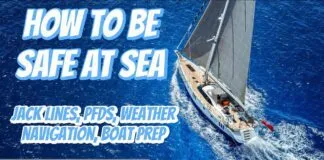
Safety At Sea For You & Your Family – The Joe...

What’s The Best Vinyl Window Cleaner for Your Boat?

40-Footer Boat Tours – With Some Big Surprises! | Boat Tour

Electrical Do’s and Don’ts
- Privacy Policy
- Do Not Sell My Personal Information
- Online Account Activation
- Privacy Manager

IMAGES
VIDEO
COMMENTS
Boat Review: Catalina 545. Tom Dove. Jun 9, 2021. Catalina has long been the largest All-American family cruiser company, building what sailors might call "standard" boats. Moving up from the popular 30ft to 45ft sizes puts the company into "yacht" territory, and the new Catalina 545, winner of the SAIL magazine 2020 Best Boats award ...
Cruising World Judges named the Catalina 545 the Best Full-Size Cruiser Over 55 Feet for 2020. The Catalina 545 sailed very well in marginal conditions. Jon Whittle. So here come the Big Boys: the four finalists in the BOTY Class of 2020 vying for the title of "Mightiest Monohull" of them all. It would not be a cut-and-dry choice, however ...
Boat Review: Catalina 425. With this, the fifth model in Catalina's "5" series of cruising boats, head designer Gerry Douglas has taken a second bite at the competitive 40-42ft market segment. The original Catalina 42 went through several iterations to become one of the most successful boats ever in this size range, with more than 1,000 ...
Which brings us to the Catalina 34. Exactly 1,800 Catalina 34s were built between the years 1991-1999, and the boat has gone through several iterations. The hull we focus on here is the relatively narrower one built between 1986 and 1995, generally referred to as the Mark 1, or Mark 1.5. The Catalina 34 sold between 1994 and 2001 (production ...
The Catalina 27 has been in production since 1971, and well over 6,000 of them have been built. This is undoubtedly the largest production run of any 27′ sailboat in US history, and probably the biggest anywhere. The flip side of the coin is that Catalinas are known as cheaply built boats, with lots of corners cut.
Practical Sailor is different. Its candor is as sharp as a marlin-spike and its honesty as welcome as a steadfast quartering breeze. And that goes for its acclaimed boat reviews. Over the years, we've reviewed the Catalina 27, 30 and a dozen other Catalina models. For each boat, we take a revealing look at the specifications and construction.
The Catalina 30 impressively straddles the line between performance and comfort, offering decent speeds compared to competitors of the same era, despite a lower sail/displacement ratio of 15.22. The fin keel version has deeper draft, lowering the center of gravity and providing better performance upwind. A higher ballast/displacement ratio ...
To drive the Catalina 425 felt comfortable, responsive, and intuitive. It was like I knew what the boat needed. Surely, performance could suffer if sailing over-canvased and significantly heeled in big breeze, but smart sail choice and trim should easily remedy those challenges and make for a happier crew. The twin helms are appropriately sized ...
All new designs from Catalina Yachts can trace their pedigrees back to the first boats Frank Butler built in California just as fiberglass-boat building was taking off. The newest, the Catalina 375, is one of them. In coming up with a successor to the legendary Catalina 36, Catalina s long-time in-house designer, Gerry Douglas, had his work cut out for him. How do you improve on a design that has
Sailaway Price $205,000. Catalina Yachts. (727) 544-6681. www.CatalinaYachts.com. More: 2011+, 31 - 40 ft, catalina, Coastal Cruising, keelboat, monohull, Sailboat Reviews, Sailboats. Two themes—consideration and principles—epitomize the Catalina 355, CW's 2011 Domestic Boat of the Year. Boat Review from our September 2011 issue.
The Catalina 42 we looked at is a the two-cabin centerline owner's berth version. It's 43'2″ overall in length, and 13'10" wide (beam). The forward cabin is the "owner's suite". It features a pedestal berth flanked by two small settees. There are two hanging lockers and five drawers under the bed.
The engine of the Catalina 30, upgraded from 11 hp to 23 hp, is located midship beneath the dinette seat. This is, in fact, the best location for an engine in terms of weight distribution; however, it complicates the installation of the engine exhaust, leaves the machinery more vulnerable to bilge water and makes sound insulation more difficult.
We discovered the boat has a turn of speed when we overtook two 35-38-footers cruising in the same sailing lanes. One owner, who formerly sailed a Catalina 30, reports that the boat is significantly faster than the 30 or 34, and another won his cruising division the first year on the race course, sailing with a provisional PHRF handicap of 150.
The Catalina 34 was first introduced in 1986 to fill the market gap between Catalina's 30' and 36' models. Between 1986 and 1995 the design remained pretty much unchanged except for the incorporation of a transom swim platform in 1990 and newer models. The length is 34' 6" overall, 29' 10" at the waterline, and the beam is 11' 9".
August 30, 2022. Catalina sailboats have always been known for durability and quality, but they have some common issues to look out for. Catalina sailboats, especially older vessels, commonly suffer from deck core failure, mast boot compression fatigue, keel separation, chain plate attachment failure, and fiberglass delamination issues.
The 350 is built at Catalina's Florida factory. A typical price for a 350 with standard equipment, including sails, is $123,500, plus shipping and commissioning. Owners tell us that the addition of electronics, oversized headsails, and upholstery upgrade, puts the final tally at $140,000-150,000. Conclusion.
The Catalina 400 mkII was a beautiful boat to walk through, and we really enjoyed looking at it. Last week, we released our 14th episode, which was a video boat tour of the Catalina 400 mkII. In previous previous reviews, we saw a Catalina 350 and a Catalina 42. Now, the 400 - right in the middle.
Builder:Catalina Yachts, 818-884-7700, Price: $254,950, FOB Largo, FL. Our Take. Pros: Easily-driven hull and user-friendly sailplan; ... Boat Review: Beneteau Oceanis 37.1. I could feel the boat find her groove and settle in at 7.2 knots on a beam reach with the code zero flying. It was a crisp autumn day on Chesapeake Bay and we were hauling ...
sailhog. 3336 posts · Joined 2006. #2 · Jul 18, 2008. Wingman, Pre-1988 C30s have a wood laminate keel stub, which is said to cause the "Catalina smile," and which in turn causes crevice corrosion of the keel bolts. A sailor who goes by Halakai on this forum has the whole nine yards on the problem, while another truly wise sailor (Max Munger ...
As is evident in this Catalina 350 currently listed in Deale, Maryland, the teak interior is quite attractive. The 100% sail area on these models is 613 square feet, but many originally came with 135% genoas that added another 100 square feet or so. Two drafts are available: a 6'6" fin keel and a 4'5" with a wing for shallow water.
The Catalina 22 was the first boat built by Catalina. The Catalina 22 that we are reviewing here was in production from 1969 until 1995, when the Catalina 22 MkII was introduced. During this more than quarter-century of production, several incremental changes were made, with several significant upgrades in 1986, when a wing keel version was ...
The Catalina 380 was designed and built for weekend and vacation sailing with the added capability of an occasional offshore jaunt and extended sabbatical cruise. When the choices narrowed during final deliberations, the judges pondered a simple question: Of the 10 boats in the class ranging from 32 to 39 feet, which would they choose were they ...
Contact- Catalina Yachts, 21200 Victory Boulevard, Woodland Hills, CA, 91367; 818/884-7700. Darrell Nicholson. Practical Sailor has been independently testing and reporting on sailboats and sailing gear for more than 50 years. Supported entirely by subscribers, Practical Sailor accepts no advertising.